Structure
How to structure a story

Home > Resources & Worksheets > Story Writing > Structure
The plot structure of a story is just as important as its characters and settings, as it allows the reader to follow the series of events that happen in a story, making each step clear and intentional.
This guide includes everything your child needs to know about story structure, from how to plan their first draft, to writing the closing paragraph!
Planning a story
The secret to writing a good story is making a plan before you begin writing. Story writing without planning can make the writing process much more difficult. Planning stories can be an especially helpful process for your child if they’re struggling with story writing in general. It can lead to much better storytelling, with a better plot and character development.
Story planning is important because it ensures that a story’s plot makes sense and flows well. It can also help prevent writer’s block, which happens when the author feels stuck during the story writing process.
How do you plan stories?
When planning an entire story, it’s always a great idea to divide it into three parts: beginning, middle, and end. There are many ways to structure a story (which we’ll get into later in the guide) but, generally, whether your child is planning a short story or a novel, these three simple parts are always present.
Planning will help your child decide what they’d like to write at different points in their story, which will make the writing process less overwhelming and more enjoyable.
There are many different methods of story planning, so it may take some time for your child to figure out which one works best for them and their writing process. Trial and error is key when trying different methods of planning stories!
Top tip: We recommend giving the snowflake method a try next time your child is planning a story. This planning method encourages authors to start their story planning process by writing a single sentence, detailing the main plot, idea, or sentiment of the story. From there, writers can start branching out, from thinking of main events in the story, to characters, settings, and then small details, until they get enough information to write their first draft.
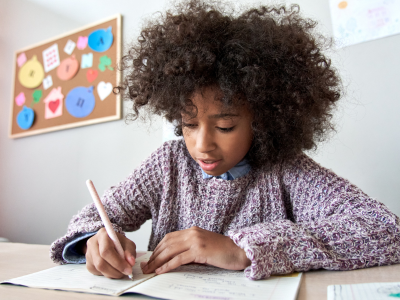
Types of story structure
There are many different story structures, some of which have been around since the Ancient Greeks invented theatre! For example, the three-act structure was made popular through Greek plays, and it’s still one of the most popular forms of story structure.
The three-act structure is very simple and suggests that the narrative structure of a story should consist of a beginning, a middle, and a clear ending. As this type of structure was first used in plays, stories were split into three acts: the first act introducing the characters and settings, allowing the audience to see everything within its “ordinary world”. The second act was where the main action of the play took place. Finally, the third act showed the resolution of the problem/conflict, as well as the conclusion of the story.
Over the course of time, more story structures have been introduced to the story writing process in an attempt to innovate and provide readers with brand new experiences, which is something your child should always aim to do with their stories!
For example, Dan Wells, a science-fiction writer, made the seven-point story structure popular, which states that there are actually seven parts in each story:
- The hook: this is the very beginning of a story, where the characters, setting, and environment of the story are described. It’s meant to show the characters in their comfort zone, or at least in a world that is yet to be changed.
- The first plot point: an inciting incident happens to disturb the peace or the ordinary world the characters live in. This is where the story starts, much like a trigger.
- The first pinch point: this is where readers may encounter the story’s villain, or when the main character starts doubting their ability to solve the problem or conflict of the story.
- The midpoint: at this point in the story, the characters involved may have made a significant discovery, or had a big realization - something that should get them on track to solving the problem they face. This is also when the action intensifies - it’s go time!
- The second pinch point: so close, and yet so far! This is where something goes wrong - maybe the main character has chosen to follow a false lead, or there is a negative shift in morale, so much so that it almost makes the characters give up on solving the issue at hand.
- The second plot point: everything is back on track! This is when things really start picking up, and the characters are closer to solving the problem than they’ve ever been!
- The denouement: the main plot of the story, as well as any subplots that may have existed, finally come to an end and there’s a clear, closed story circle.
Following a classic story structure
Now that we've looked at some popular story structures, let’s take a classic approach to help your child plan and write their next story:
The Beginning
The beginning of a story plan should paint a clear opening image of what the reader needs to know from the story's starting point. This may include a backstory, certain features of the characters, settings, or environment of the story. Remember, the beginning of a story also needs to catch the reader’s attention!
Here are some key questions for your child to consider when planning the beginning of their story:
- Where is your the set? Is it set in a new world?
- What does the reader need to know about the main character(s)? Are the readers following the hero’s journey? Does this character have any allies or sidekicks?
- How should the reader feel after reading the beginning of the story? What can be done to set the mood?
- Is there a way to grab the reader’s attention from the start?
The Middle
The middle of a story plan can look very different depending on what kind of story your child is writing. The middle section often has the bulk of the story; it typically presents the conflict or main point of the story. This is where they can be the most creative with the story plan! Here are some key questions for your child to consider when planning the middle of their story:
- Is there going to be a problem or conflict that arises for the character(s)?
- If there is no problem, what is the main point of this story? Does the main character find a magical elixir? Maybe they have to face their own fears?
- What key information is necessary for the readers to understand in the middle of the story?
- How will they continue to hold your reader’s attention in the middle of your story?
The End
The end of the story is typically where any concluding thoughts are expressed, and when a resolution is reached if there was a problem at hand, painting a full, final image of the narrative. The end of your child's story plan should include how they intend on leaving the readers feeling and what they want them to be thinking about when they finish reading their story.
Here are some key questions to consider when planning the end of a story:
- If there was a conflict present in the story, how is it resolved? Or is it resolved at all?
- Are there any concluding thoughts that need to be included here?
- How should the readers be left feeling once they’re done reading this story?
- Does your child want to include a surprise ending or a cliffhanger? How are they tying any loose ends that may have been a result of the main plot?
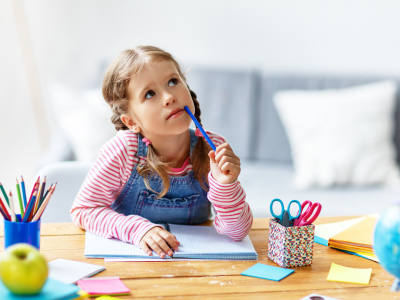
Story Arcs
A story arc is the term used to describe the path a story takes, and is also known as a story's plot. In order to write a successful story arc, it’s important your child understands how to build up their narrative.
How do you build up a narrative?
Building a strong narrative structure is a very useful tool to use in any story where an important event happens in the middle or end of the story.
Here are the five features of story arcs, to help your child build the perfect narrative:
1. Exposition
The first element of a story arc is the exposition. The exposition component of a story arc introduces the story and includes background information that readers need to know. Then, the story really begins and the plot starts to become engaging!
2. Rising Action
After the exposition, a rising action will occur, which is what starts to build up the narrative towards a climax. The rising action is a type of action that instigates the turning point of the story, to successfully build towards the climax of a story. This action is important because it often changes the course of the story completely.
3. Climax
Next, the climax occurs. This is the main event in any story, and it can take many different forms. How the climax appears will depend on what the main event of your child’s story is, what genre they’re writing, and how they want the climax to be received by their readers.
4. Falling Action
Following the climax is the falling action. This is where the tension built from the rising action and climax starts to fade in your child's story. The falling action will show that the biggest problems were solved in the climax. It’s usually clear in a story when the climax occurs, and the falling action is what follows that.
5. Resolution
A resolution is the typical way to finish off any story. This part of the story arc gives the readers a sense of how everything is left at the end of the story. The resolution should reinforce the message the author wants their readers to take away from the story. It should also show the final sentiment that is felt by your child's characters, making the readers feel that same way.
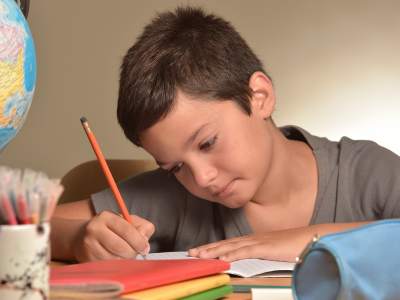
Story Problems & Solutions
Many of the best stories are centered around problems and solutions. Often, problems are introduced in the middle of stories and resolved at the end, keeping readers interested in a story until everything is resolved! If your child is relatively new to story writing, introducing the importance of problems and solutions will greatly benefit their ability to form a plotline.
How to create problems for storylines
It is important for your child to consider how much of the storyline they want the problem to take over, with either a minor or major problem. When brainstorming ideas for story problems, problem resolution is also a component to keep in mind.
Here are some questions for your child to consider:
- Should the problem be big or small? Should it be easy or hard to solve?
- How will the readers react after they're introduced to the problem?
- How will the character(s) handle the problem?
- When will the problem be introduced?
- What is the greater impact of the story's problem?
Examples of story problems
There are plenty of types of story problems, all of which also help to build character arcs. Here are some story problems that your child can use in their next story:
Character vs Self
This story problem involves an inner conflict within one of the story characters. They're struggling with their inner thoughts, beliefs, concerns, fitting in with the status quo, or being in an unfamiliar situation.
Example
A woman wishes to travel the world but is too scared to do so.
Character vs Character
This story problem involves a conflict between two of the story's characters. This could be a classic villain vs hero scenario, but it could also be between two friends or family members in the story.
Example
Two best friends are competing to get the highest score on their upcoming math test.
Character vs Society
This type of story problem can present itself in many different ways, but involves a “self versus the world” mentality. This problem often occurs because the character disagrees with certain ideas, beliefs, or practices of the society they’re living in.
Example
A teacher struggles to convince the town council for more school funding.
Character vs Nature
This type of story problem is a conflict between a character and the world around them but in a more physical sense. It’s different from the character vs society conflict because it focuses on the natural world rather than the societies within it. A character vs nature story problem could involve a natural disaster, for example.
Example
A person who’s never been camping before gets lost in the woods.
Character vs Supernatural
This type of story problem is often used in fiction stories that involve magic, powers, or the supernatural. The character vs supernatural problem involves issues between a person who has no powers and some type of character who does, for example.
Example
A person is being haunted by a ghost.

Story Endings
A great story builds up to its ending! Although the ending is not the entirety of a story, it can immensely change the overall sentiment a reader feels after they finish reading.
Choosing how to end a story comes with a lot of responsibility, because depending on how it ends, the reader may end up with their questions answered, or may develop an entire new list of questions. It can be satisfying or dissatisfying to a reader, depending on how the story ends!
Here are some examples of story endings your child may want to use:
The Cliffhanger
This type of story ending leaves the readers wondering what happens next. The story is unfinished, and the readers are left to their own thoughts to try and guess what happens next. Cliffhangers are effective because they leave readers wondering intensely about how the story was supposed to end, or how they wanted it to end.
The Twist Ending
The twist ending is a type of story ending in which the readers are surprised by what happens. This ending is especially useful because it shocks the readers, making them rethink the entire plot of the story.
The Resolved Ending
This type of story ending is typically what readers expect from a story. Once the problem is introduced in the midpoint of the story, it’s expected that by the end, it will be resolved. That is exactly what this type of ending is: problem resolution. This is the typical “happily ever after” ending where everything goes exactly the way the characters want, and exactly how the readers anticipate. This type of ending leaves readers feeling satisfied with how it turned out but doesn't cause any surprise to them.
The Unresolved Ending
This story ending is when the problem is not resolved at the end of the story. However, it is different from a cliffhanger because the readers actually know the problem wasn’t able to be solved. The unresolved ending is a useful tool when your child wants to give their readers closure but not the type of expected closure they might get from a resolved ending.
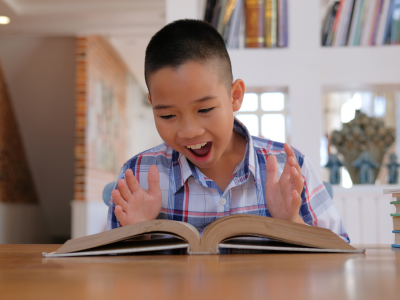
Plot Twists
There are several different things that make a good story: expansive vocabulary, character development, and an exciting plot. A plot twist is a literary technique in which an unexpected change in the story occurs. It involves an unpredictable shift in a story, which catches readers off-guard and encourages them to keep reading.
Plot twists are important because they make a story much more interesting and exciting!
How do you write a plot twist?
Plot twists are really easy to identify in someone else’s story, but are much harder to write in an original story. They require a lot of creative thinking!
Here are some tips for your child to create good plot twists in their stories:
- Build tension from the start of the story that will lead up to the plot twist. This makes a plot twist much more exciting once it actually happens!
- Make sure the plot twist makes sense within the context of the story. Although plot twists need to be surprising, they also need to be believable.
- Don’t introduce the plot twist too soon into the story, or the readers won’t be surprised!
Some different plot twists include:
The Red Herring
This type of plot twist is often found in a detective story or a mystery. This is one of the most widely used types of plot twists. The idea is to mislead the reader and hide the truth from them until the big reveal moment.
All In The Imagination
In this type of plot twist, the author reveals to the readers that part (or all) of the plot they had just read about did not really happen; it was all in one of the character’s imaginations. This plot twist comes as a shock to the readers because it makes them question everything they had read up until this point in the story.
The Flashback
The flashback plot twist involves showing the readers a specific memory from the mind of one of the characters that reveals shocking or important details from the past. This type of plot twist doesn’t change the plot in real-time but is exciting because of the new information that the reader discovers.
Who is the real villain?
With this type of plot twist, the author attempts to convince the reader that they know exactly who the villain is from the beginning of the story. There is usually one obvious villain from the start. However, as the story continues, the author reveals the real villain, which turns out to be someone the readers never would’ve expected.
Activity & Resource
Now that we've provided solid background information on all things structure, here's a collection of resources your child can use to practice everything they learned!
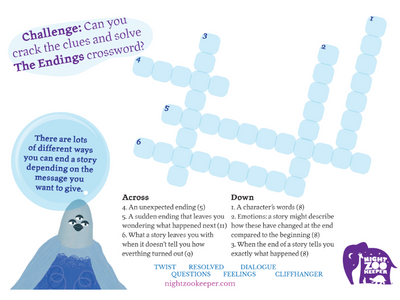
How Night Zookeeper can help

Our reading & writing program for kids offers thousands of games, challenges, lessons, and other resources to keep your child entertained while they learn.
Join Nightzookeeper.com to improve your child’s writing skills and get a FREE 7-day trial!
More story writing resources
- Story Characters
- Story Settings
- Story Writing (overview)
Related content


Make Reading & Writing Fantastically Fun!
- Award-winning reading & writing program for kids
- Improves spelling, grammar, punctuation & vocabulary
- Over 1,000 different learning games and activities



